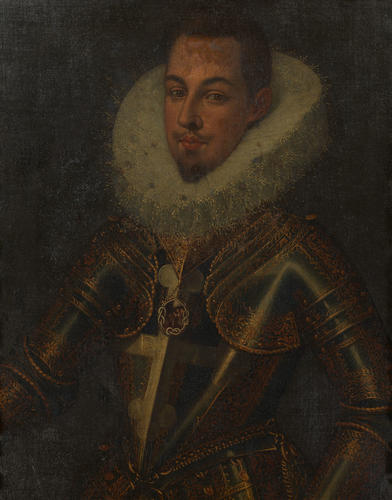Emmanuel Philibert, Duke of Savoy (1528-1580), traditionally identified as c.1550-80
Oil on canvas | 74.6 x 59.3 cm (support, canvas/panel/stretcher external) | RCIN 406164
-
This portrait, by an unknown Spanish artist of the sixteenth century, is traditionally identified as Emmanuel Philibert, Duke of Savoy. Known as 'Testa di ferro' or 'Ironhead' because of his military prowess, the Duke was a skilled political strategist and one-time suitor to Lady Elizabeth Tudor, later Queen Elizabeth I.
Emmanuel Philibert was the second cousin and nephew by marriage of Holy Roman Emperor Charles V and first cousin of his successor, Philip II of Spain. He served Charles V in the war against Francis I of France and as leader of the Spanish invasion of northern France, the Duke won a famous victory at Saint-Quentin in 1557. On succeeding to the title of Duke of Savoy in 1553, Emmanuel Philibert inherited lands that had been under French control since the 1530s. In the hope of reclaiming his lands, the Duke continued to serve his Spanish Habsburg cousins, governing the Netherlands in the name of Philip II from 1555 to 1559. Following the end of hostilities between France and Spain in 1559, the duchy of Savoy was restored to the Duke and as part of the peace treaty; he married the French King's sister Margaret of Valois. Emmanuel Philibert spent the remainder of his life regaining lost territories, shrewdly taking advantage of European squabbles to reclaim land from both France and Spain.
This portrait shows the Duke aged about twenty five. Painted life-size in three-quarter, he wears an ornate suit of armour, decorated with gold and with a white Botonée or Cathedral cross on the breast plate. A large jeweled pendant, possible amber, hangs from the neck plate and he wears a large quilled ruff edged in lace. The direct gaze and confident pose of the sitter are consistent with Spanish court portraiture of the mid-sixteenth century.Provenance
Probably the painting of this size described as a 'Knight of Malta in a ruff, his armour wrought with gold' recorded in the King's Privy Gallery at Whitehall in 1666 (no 96); difficult to identify again until it turns up in the Lord in Waiting's Bedroom at Windsor Castle in 1878 (WC no 819)
-
Creator(s)
-
Medium and techniques
Oil on canvas
Measurements
74.6 x 59.3 cm (support, canvas/panel/stretcher external)
85.7 x 70.7 x 7.0 cm (frame, external)
Alternative title(s)
Man in armour, previously entitled








